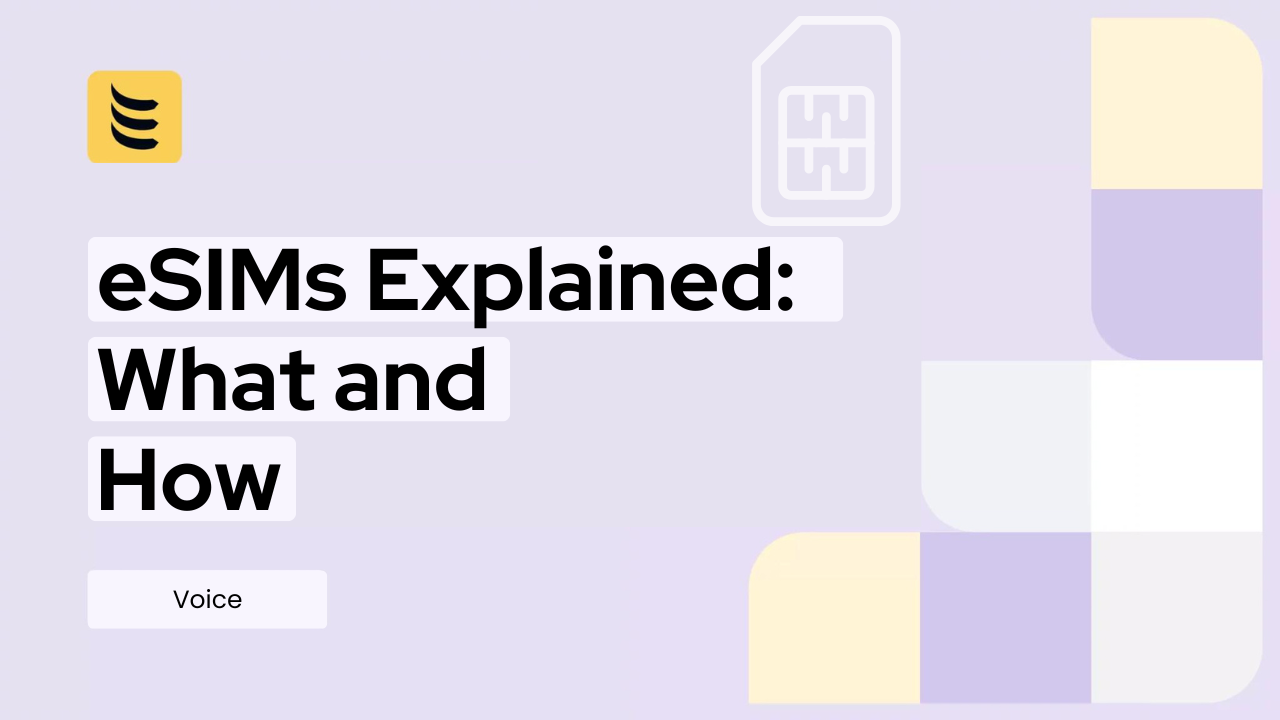Introduction
The notion of swapping SIM cards seems so last century. Everyone prefers things to be simpler, particularly when switching phones or crossing borders. That’s where eSIMs enter the equation.
An eSIM is simply “embedded SIM.” It works the same as a regular SIM card, but you don’t have to push it in and out of your phone. It’s already included in your phone when you buy it. You just switch it on with some taps.
More phones now support eSIMs. Some even ship without a physical SIM slot at all. Carriers around the world are also catching up. If you’ve never used one, this is the right time to understand how it works and what it offers.
What Is an eSIM?
An eSIM is a tiny chip inside your phone or tablet. It keeps your phone number and links you to a mobile network. Just like a regular SIM card, it lets your device send messages, call, and get data.
But here’s the difference: you don’t have to manipulate or touch anything. You don’t have to pull out a tray or swipe a plastic card. Your carrier sends you a code or a setup link. You scan it, and your phone is connected.
Because it’s virtual, an eSIM is able to hold more than a single number. You can browse through them in your settings. It’s handy for people who travel, have business and personal numbers, or require different data plans.
It’s safer too. A physical SIM can get lost, broken, or stolen. An eSIM stays in your phone, and no one can pull it out. You can take it out or change plans, but all of this is done through software.
eSIM vs. Physical SIM: What’s the Difference?
A physical SIM is similar to a small card that you insert into your phone. You need to have it in order to link up to your provider and use your number. When your carrier or plan changes, you normally need to remove it and insert a new one.
An eSIM does exactly the same, but it’s inside your phone. You don’t touch anything. Your number and plan are put into the phone using a code or an app. It’s all done on your screen.
The major difference is how you switch it on and flip. You remove one card and insert another with a standard SIM. You scan a code and press a few buttons with an eSIM. There is no tiny tray to pop open, and nothing to lose or destroy.
An eSIM also allows it to be easy to use multiple plans. Some phones enable you to have several eSIM profiles stored and switch them when the need arises. For example, you can have one for company use and one for personal. Or you could have a travel plan without having to take off your main number.
Physical SIMs continue to work and be in use. But eSIMs are taking over because people want quicker ways of connecting and switching.
How Does an eSIM Work?
To use an eSIM, you need to have a compatible device and a mobile phone plan from a carrier offering eSIM service. The majority of new tablets and phones ship with this feature.
It starts when your carrier gives you a QR code or a link. You go into your phone’s settings, choose to add a new mobile plan, and scan the code. Your phone downloads your plan and connects online. You do not need to visit a store or wait for a SIM to be sent to you.
If your device allows it, you can store more than one eSIM profile. It is convenient if you frequently travel or need more than a single number. You can swap between profiles on your phone settings instantly without replacing any hardware.
Some devices also let you use an eSIM and a physical SIM at the same time. That is, you will have the ability to turn on two lines at the same time—one for voice and one for data, or one for work and one for personal.
All of this is controlled through software. That accelerates setup and reduces the risk of damage or loss. If you ever need to update or delete your plan, you can do so with just a few taps.
eSIM benefits: Why Users are Switching
One of the biggest reasons eSIMs are so popular is because they’re so easy to activate. You don’t need to visit a store, stand around and wait for shipping, or play with tiny trays. You just scan a code, and your phone’s online.
If you travel a lot, eSIMs are a dream come true. You can buy a local plan even before you arrive at the airport. You don’t have to pull out your main SIM or risk misplacing it. Some apps even let you pick and activate a travel plan in minutes.
eSIMs are also useful for people who need more than one number. You can keep a personal plan and a work plan on one phone. You don’t need two phones or two SIMs.
eSIM phones need fewer small pieces. That allows designers to make other aspects—like battery size or water resistance—better. There’s less plastic and packaging, too, so there’s less waste that ends up in the environment.
For businesses and IT teams, eSIMs are a breeze to manage. They can provision mobile plans onto phones without needing to send cards or set up phones manually. This is convenient and time-saving.
eSIM Shortcomings: Things to Keep in Mind
Despite all the advantages, eSIMs have drawbacks. Not every phone or carrier supports them.
Before making the switch, ensure that your phone supports it and your carrier has eSIM service.
Some phones let you have an eSIM and a physical SIM active at once. Others don’t. It depends on the model. If you like having two numbers active, research your phone first.
It isn’t always simple to move an eSIM to a new device. I may have to request help from my carrier or wait for a new setup link. It isn’t quite as easy as removing a SIM card and putting it into another device.
Also, if your phone is lost or stolen, it can take longer to port your number. With a physical SIM, all you need to do is insert it into a new phone. With an eSIM, you will need to begin the setup process from scratch.
Overall, eSIMs are really convenient, but they don’t always play plug-and-play. A little planning is nice.
Devices That Support eSIM
Many new phones now support eSIM. If you’ve bought a phone in the last couple of years, there’s a good chance it works with eSIM.
Apple added eSIM to iPhones starting with the iPhone XS. All newer models, including the iPhone 15, support it. In some countries, newer iPhones don’t even have a physical SIM slot anymore.
Samsung also supports eSIM in the majority of its Galaxy phones, notably in the S and Z series. Phones like the Galaxy S22, S23, and Z Fold support eSIM. Not all, though, so check your phone settings or manual.
Google has introduced eSIM as a feature in its Pixel phones from the Pixel 3. All Pixels thereafter have it built-in.
Some tablets, like iPads and Microsoft Surface devices, have eSIM as well. As do some smartwatches, like the Apple Watch and Samsung Galaxy Watch. This means that they can stay connected while your phone is nowhere in sight.
Access to laptops with eSIM is also easy now. They’re handy for those who need internet connectivity when on the move without having to use Wi-Fi or tethering.
Before you switch to eSIM, it’s always best to check your phone’s settings or search online to make sure it’s supported.
Who Uses eSIMs and Why It Helps
eSIMs aren’t just for tech lovers. Lots of everyday people benefit from using them.
Travelers save time and money most. Instead of spending money on costly roaming fees, they can purchase a local data plan in minutes. Most eSIM apps simplify it. One does not have to search for a store or keep an extra SIM.
Remote workers and digital nomads like eSIMs too. They switch cities or countries often. With eSIM, they don’t have to swap their primary number but stay connected.
People with two numbers—one for work, one for personal use—can keep both on one phone. You don’t need two devices, and you don’t have to swap cards. You just tap to switch between numbers.
Parents use eSIMs to manage kids’ phones. They can add a data plan without sacrificing a full SIM. They can switch or remove the plan, if needed, without equipment.
Companies also have the advantage when using eSIMs. IT administrators can push plans to employee devices without sending anything. Time is conserved and wait time is removed. It’s also handy in installing multiple devices at once.
Tablets and smartwatches also have the advantage. eSIMs keep them online even when there is no phone nearby. For those who would like constant connectivity, this is a good choice.
Final Thoughts
eSIMs ease mobile use. They dispense with the hassle of plastic cards, trip storage, or shipping delays. You can change plans, switch numbers, or switch carriers with little hassle.
They are perfect for visitors, remote workers, families, and anybody who wants to gain more control over phone service. They reduce waste and enable phone makers to have additional real estate to innovate hardware.
However, they’re not perfect for everyone. They’re not currently supported by all phones or carriers. Changing your plan to a different phone might take more effort. But if your phone and your carrier support eSIM, it can’t hurt to try. The way we stay connected is changing. eSIMs make the change easier, sooner, and for most people.




